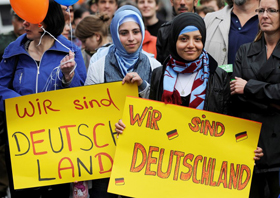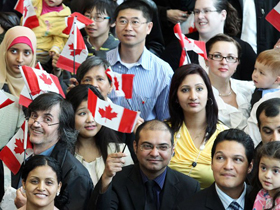Multiculturalism in Western Europe: Beyond the Rhetoric
In
Login if you are already registered
(no votes) |
(0 votes) |
Doctor of Political Science, Leading researcher, RAS Institute of Philosophy
Countries of the New World – the United States, Canada and Australia – are known as “immigration states” for good reason: the American, Canadian and Australian nations are all products of immigration. Immigration is essential to each of these countries’ identity as a nation-state. Western Europe is quite different. The nation-states there emerged before the massive influx of migrants. This is why attempts to plant public rhetoric and political practice, peculiar to immigration countries, in European soil are bound to seem awkward. The issue is multiculturalism.
Countries of the New World – the United States, Canada and Australia – are known as “immigration states” for good reason: the American, Canadian and Australian nations are all products of immigration. Immigration is essential to each of these countries’ identity as a nation-state. Western Europe is quite different. The nation-states there emerged before the massive influx of migrants. This is why attempts to plant public rhetoric and political practice, peculiar to immigration countries, in European soil are bound to seem awkward. The issue is multiculturalism.
Multiculturalism, at least on the rhetorical level, gained ground in a number of European countries in the 1980s-early 1990s. However, it soon waned, giving way to disappointment or outright hostility. In 2010-2011, the leaders of the key EU countries expressed the essence of these sentiments by announcing the failure of multiculturalism.
These bold statements, however, leave a number of questions unanswered. Was the call for multiculturalism in Europe in fact mimicking a fashion in North America? Was multiculturalist rhetoric backed by systematic policy? And, if so, was it really a failure? Can we really call strategies related to multiculturalism futile?
Achieving Conceptual Clarity
To ensure any study of multiculturalism is meaningful, it is necessary to agree on what the terms used actually mean, which is not easy since the term multiculturalism itself has no broadly accepted definition.
In everyday life multiculturalism is identified with ethnic, linguistic, religious and life-style diversity in society. If earlier this stemmed primarily from the historical heterogeneity of the population in most modern states, in the post-war decades it was mostly brought about by immigration. That's what mass murderer Breivik was referring to when he claimed he wanted to “save Europe” from multiculturalism.
The second aspect of multiculturalism relates to the practical reality in politics and governance: a certain system of steps taken by the state to maintain cultural diversity. A closer look will reveal that not many states pursue any such policy. Strictly speaking, institutionalized multiculturalism, i.e. multiculturalism that is enshrined in the laws and embodied in the relevant institutions of state, exists only in Canada and Australia. The law in these two countries identifies society as a set of ethnic groups whose equality in access to resources is regulated by the state.
Institutionalized multiculturalism, i.e. multiculturalism that is enshrined in the laws and embodied in the relevant institutions of state, exists only in Canada and Australia.
Despite its avowed commitment to the ideals of cultural diversity, the United States defines society as a single indivisible nation. The support of multiculturalism is mainly confined to the practice of affirmative action (i.e. positive racial discrimination) in university admissions, as well as changes to the curriculums, which vary greatly from state to state. There is also the image-making policy that the United States pursues both at home and abroad to demonstrate its backing of cultural diversity. However, they appear to draw the line at American multiculturalist activities [1].
So, we should clearly distinguish between rhetoric and practice, i.e. between public statements and symbolic gestures by the government and particular actions.
And finally, the third aspect of multiculturalism is ideology. Multiculturalism is often assumed to be a kind of doctrine, a world-view, and a stable system of opinions, in short – an ideology. However, this assumption is not quite true since civil activists who preach multiculturalism use the word to express different things. Interpretations vary from simply stating the legitimacy of cultural differences in a public space to viewing the society as a conglomerate of ethnic and cultural communities whose identity that the state should protect [2].
What Provompted Europe to Take a Multiculturalist Turn in the 1980s?
Appeals to the ideas of multicultural society by both the bureaucracy and the public reflect a pressing need to accommodate the migrant population in the host country.
Though it is generally believed that the emergence of multicultural vocabulary in the European public and political discourse was an intellectual import from the United States and Canada, in truth the causes lie deeper. Appeals to the ideas of multicultural society by both the bureaucracy and the public reflect a pressing need to accommodate the migrant population in the host country. This urgency snowballed as ever more guest workers arrived and settled for good (often with their children, for whom European states became home). And since assimilation, i.e. the migrants’ complete adoption of their new socio-cultural environment, was clearly unfeasible, the formula of integration without assimilation appeared. This explains the popularity in Europe of the 1980s-early 1990s of such figures of speech as the respect for cultural distinctiveness and the right to identity. This approach was meant to prevent the appearance of an ethnic underclass and, consequently, the ghettoization of migrants and their descendants in Europe.
Many believe not only that this mindset has failed, but that it also caused the collapse of the migrants’ integration in Europe. The underlying conjecture goes further: if Europe had been less enthusiastic about multiculturalism and from the very beginning focused on assimilation, the results of integration would have been much more impressive. However, this assumption is also wide of the mark.
For one thing, the source of immigration-associated problems lies outside culture per se. It is primarily defined by its social aspects, with the rhetoric of multiculturalism promoting their culturalization, i.e. their transfer from the structural realm to that of morality and psychology [3]. Second, the content of this appeal to multiculturalism, as well as the scope of its distribution in Europe require serious revision. The hard fact is that multiculturalism, so popular in the late 1980s-1990s, was chiefly represented in public rhetoric rather than real politics.
Actually, only two countries in Europe – Sweden and the Netherlands – have made concrete steps to implement the ideas of multiculturalism. Government measures to support migrant minorities were implemented in Sweden from the mid-1970s and in the Netherlands from the early 1980s. The state provided migrants with financial and infrastructural support to ensure their right to native-language education, media, cultural events, etc. However, the scope of these packages should not be exaggerated. They predominantly addressed the needs of the ethnic migrants’ activists rather than the majority of the migrant community. Note that in the second half of the 1990s, both countries took a step back. In Sweden, the law giving immigrant communities equal status with historical minorities (Laplanders, Finns) was revised, while in the Netherlands the minority development program, launched in 1983, was phased out [4].
The United Kingdom deserves separate attention as it is known as a devoted promoter of cultural pluralism. However, British multiculturalism, in fact, boils down to a liberal laisser faire attitude in relation to the public display of ethnic differences. The UK has no specific measures in place to support ethnic minorities. The establishment of the Commission for Racial Equality in 1976 seems to be the only discernable development in Britain feature that draws the country closer to the United States and distinguishes it from its neighbors in continental Europe. The Commission monitors ethnic discrimination and enjoys official recommendatory powers. Among other things, the Commission has recommended the adoption of positive discrimination in certain areas (for example, for police job applicants). Be that as it may, the UK’s multiculturalist policy remains more symbolic than instrumental [5].
As for France, whose President in February 2011 strongly disassociated himself from multiculturalism, the country has always sought to isolate itself from this concept, even at the rhetoric level [6]. French officials and intellectuals have always insisted on the inviolability of the values of the republic, i.e. the strict adherence to the principle of secularism, and the freedom of the public space from any demonstration of cultural distinctiveness. All differences related to religious or linguistic affiliation are confined to the private sphere [7].
Multiculturalism, so popular in the late 1980s-1990s, was chiefly represented in public rhetoric rather than real politics.
In Germany, the Chancellor’s statement on the failure of multiculturalism in autumn 2010 triggered heated debate in the media, which even reached Russia. However, the German policy of multiculti pursued goals entirely different form those of the above-mentioned countries. In the Dutch, Swedish and, in part, British cases, multiculturalism – whatever the term implies – was to serve as an instrument to integrate migrants and their descendants, while in Germany it served the opposite purpose, to prevent Turkish migrants from becoming part of German society. It is no secret that separate schools for Turkish children were not created because German authorities were keen to protect Turkish identity. The authorities had to secure the return of the Turkish children to their parents' homeland. Multicultural measures in Germany have thus focused on segregation rather than integration [8].
The particular features of the German case were largely determined by the country’s restrictive citizenship legislation, which had been in force until the end of 1999. It set high barriers to the naturalization of foreigners, de facto removing potential citizens from the political community [9]. In other words, the existence of a parallel Turkish society is the result of the German state’s policies. However, rather than associating the poor integration of German Turks with these structural factors, Angela Merkel chose to blame “multiculturalism.” European leaders seem to have first invented the multiculturalism monster and then declared war on the beast.
Shrewd observers recorded a shift from pluralism to assimilation in the early 2000s [10]. It should once again be emphasized that this change covered the symbolic sphere more than it did that of realpolitik. In addition, many countries did not even have to make any such change for the simple reason that they had never displayed much enthusiasm for multiculturalism [11].
Is the Comeback of Multiculturalism a Reality?

"We are Germany": Turkish-German
protesters in Solingen attend a demonstration
against German politician Thilo Sarrazin,
whose new book has been blasted as racist
At present the political class across Europe is laying particular emphasis on the priority of civic integration. The previously popular talk of cultural diversity is relegated to the back burner [12]. However, in the not too distant future, public discourse may undergo another shift, and the values of cultural dialogue and mutual tolerance will again overshadow those of national cohesion. This scenario appears likely, since the avowed adherence to the virtues of assimilation is intended for domestic audiences. In foreign policy and image terms it has always been more productive to demonstrate the state’s willingness and ability to guarantee the rights of citizens to their cultural identity. It is no accident that international legal instruments (such as the European Framework Convention for the Protection of National Minorities) contain provisions prohibiting forced assimilation.
However, irrespective of the public rhetoric – be it pluralistic or integrationist – that may prevail at any given time in any given country, the crux of the matter, i.e. the problem of incorporating the new population into the host countries’ social institutions, remains unchanged. And everyone understands what a complex and multidimensional problem we are facing.
In this connection it seems relevant to focus on the following fundamental considerations.
The modern democratic state cannot but adjust its public sphere to the new demographic realities. It must act to politically accommodate cultural differences. And the usage of multicultural terminology in this process is immaterial.
1) The process of incorporating immigrants into the host society occurs to a large extent irrespective of the integration model chosen by the country’s government [13]. Success or failure in integration is determined by numerous objective and subjective factors, with the objective, structural ones obviously having the upper hand. They include employment, unemployment, education, relevant professional skills, adequate housing, lack of direct and indirect discrimination in access to jobs, etc. If these are not properly addressed, no administrative action will ever bring about the desired effect. As is understood, the French promote republicanism while ignoring ethnic differences, while the British favor pluralism based on race and ethnicity. However, both approaches seem to have similar results, as can be confirmed by the youths who rioted in the suburbs of Paris in the autumn of 2005 and in London in August 2011.
2) The European countries implemented very similar measures. So France, no matter how vigorously its political class renounces multiculturalism, applies a similar set of measures to its neighbors when it comes to regulating communal life in ethnically heterogeneous neighborhoods. For example, the Interior Ministry cooperates with religious leaders (including Muslim leaders) on such issues as the construction of churches or local training of mullahs (to prevent the importing of imams from Saudi Arabia). The authorities in Germany, the Netherlands, Austria, Belgium, and Sweden all do likewise.
There are a number of everyday problems to be administered in a similar way regardless of national contexts and rhetorical framework. These are school and army canteens providing catering in line with religious restrictions (halal or kosher), separate cemeteries (cemetery sectors) for the deceased of different faiths, the admission of priests of various denominations into barracks and prisons, developing curriculums (primarily regarding history) taking account of the multiethnic nature of the student body, etc. Television anchormen and commentators of migrant origin play an important role: demonstrating the heterogeneous composition of European society today. Variations country-to-country in this regard are often quite significant, but the overall logic is quite evident. The modern democratic state cannot but adjust its public sphere to the new demographic realities. It must act to politically accommodate cultural differences. And the usage of multicultural terminology in this process is immaterial.
1. It is important to mention the presence in American daily life of a second language in addition to English. ATMs and payment terminals in supermarkets often have the Choose language option offering Spanish or Chinese as well as English. However, this is chiefly due to market considerations rather than administrative or bureaucratic efforts.
2. Tariq Modood is a typical proponent of this first interpretation, and Bikhu Parekh – of the second one. See: Modood T., Webner P. (eds.) The Politics of Multiculturalism in the New Europe: Racism, Identity and Community. L.: Zed Brooks, 2007; Parekh B. Rethinking Multiculturalism: Cultural Diversity and Political Theory. Cambridge, Mass.: Harvard University Press, 2000.
3. One of the first analysts to focus on this fact was German sociologist Franz-Olaf Radtke. See: Radtke F.-O. Varieties of Multiculturalism and Uncontrolled Consequences // V.S. Malakhov and V.A. Tishkov (eds.) Multiculturalism and the Transformation of Post-Soviet Societies. Moscow: Institute of Ethnology and Anthropology, 2002.
4. Soininen M. “The Swedish Model” as an Institutional Framework for Immigrant Membership Rights // Journal of Ethnic and Migration Studies. 1999. Vol. 25. № 2; Entzinger H. The Rise and Fall of Multiculturalism: The Case of the Netherlands // Joppke C., Morawska E. (eds.) Towards Assimilation and Citizenship: Immigration in Liberal Nation-States. N.Y.: Palgrave-Macmillan, 2003.
5. Alibhai-Brown Y. After Multiculturalism. L.: Foreign Policy Centre, 2000.
6. Wieviorka M. 1998 Is Multiculturalism a Solution? // Ethnic and Racial Studies. 1998. Vol. 21. № 5.
7. Wieviorka M. (avec Jocelyne Ohana) La différence culturelle. Une reformulation des débats. P.: Balland, 2001.
8. Radtke F.-O. The Formation of Ethnic Minorities: The Transformation of Social into Ethnic Conflicts in the So-Called Multicultural Society – The German Case // Rex J., Drury B. (eds.) Ethnic Mobilization in a Multi-Cultural Europe. Aldershot: Avebury, 1994; Traenhardt D. Conflict, Consensus, and Policy Outcomes: Immigration and Integration in Germany and the Netherlands // Koopmans R., Statham P. (eds.) Challenging Immigration and Ethnic Relations Politics: Comparative European Perspectives. Oxford: Oxford University Press, 2000.
9. These include the length of residence in the country needed to apply for obtaining German citizenship, renunciation of the citizenship of another state, and the lack of the jus soli norm, granting citizenship to a child born in a family of resident aliens. See: Heilbronner K. Germany's Immigration Law under Immigration Pressure / / Hansen R., Weil P. (eds.) Dual Nationality, Social Rights and Federal Citizenship in the US and Europe. Oxford: Berghahn Books, 2002.
10. Brubaker R. 2001. The Return to Assimilation? Changing Perspectives on Immigration and Its Sequels in France, Germany, and the United States // Ethnic and Racial Studies. 2001. Vol. 24. № 4.
11. Joppke C., Morawska E. (eds.) Toward Assimilation and Citizenship: Immigration in Liberal Nation-States. N.Y.: Palgrave-Macmillan, 2003.
12. Joppke C. The Retreat of Multiculturalism in Liberal Nation State: Theory and Policy // British Journal of Sociology. 2004. Vol. 55. № 2.
13. Heckmann F., Schnapper D. The Integration of Immigrants in European Societies: National Differences and Trends to Convergence. Stuttgart: Lucius and Lucius, 2003.
(no votes) |
(0 votes) |






